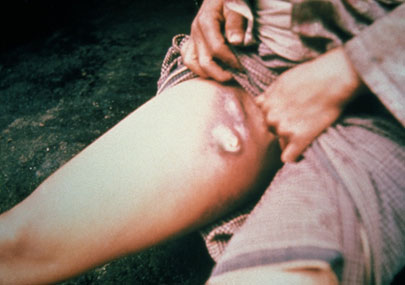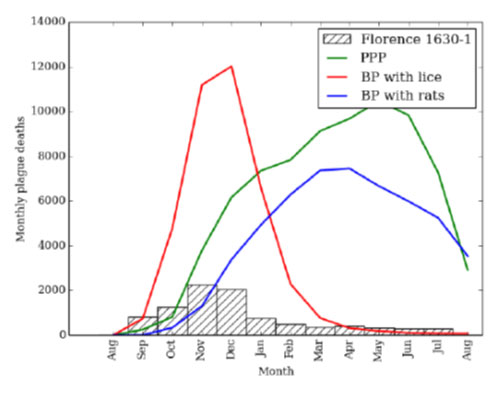Phenomenon of Amazing Detail
Plague of the Philistines - An incredibly accurate description of plague in the Old Testament
Chapter 4-6 of the First book of Samuel tells how the Ark of the Convenant was captured by the Philistines, God’s wrath of tumors and death, and the return of the Ark.
The Philistines capture the ark in battle and kill Eli’s sons. Upon hearing of the Ark’s capture, Eli dies and his daughter-in-law names her newborn son "Ichabod" [no glory]. The Philistines take the captured ark to Ashdod, where their god Dagon’s statue falls twice before the ark. The people are struck with tumors. The Ark is sent to Gath and then Ekron, with the same results. The Philistines return the ark to Beth Shemesh . Those Israelites who look into the ark are struck dead . Apparently believing Israelites suffer more severe consequences (death) than unbelieving Philistines (tumors) for disrespecting God’s Ark. The Ark is moved to Kirjath Jearim, where it will remain for 100 years. After 20 years Samuel calls Israel to put away its gods and return to the Lord. Israel repents.
1. Battle with Philistines at Aphek and Ark taken 1Sam 4:10-11 5
2. Ark taken to Ashdod temple of Dagon. Afflicted with tumors 1Sam 5:6
3. Brought to Gath and tumors broke out there. 1Sam 5:8-9
4. Brought to Ekron. 1Sam 5:10-11
Many die or end up with tumors. 1Sam 5:12
5. Tested to go by itself and it comes to Beth Shemesh. 1Sam 6:12
What is Plague? (Rat epidemic)
From the Wikipedia: “Plague is an infectious disease caused by the bacterium Yersinia pestis and is transmitted by the bite of the flea Xenopsylla cheopsis. This flea is most notoriously related to the black rat (Rattus rattus). Symptoms include fever, weakness and headache. Usually this begins one to seven days after exposure. In the bubonic form there is also swelling of lymph nodes, while in the septicaemic form tissues may turn black and die, and in the pneumonic form shortness of breath, cough and chest pain may occur.
Bubonic and septicemic plague is generally spread by flea bites or handling an infected animal. The pneumonic form is generally spread between people through the air via infectious droplets. Diagnosis is typically by finding the bacterium in fluid from a lymph node, blood or sputum”.
What occurred with the Phillistines was an incredibly accurate description of Plague:
There are no tumors in the first two days
1 Samuel 5: – in Ashdod
2 Then the Philistines took the ark of God and brought it to the house of Dagon and set it by Dagon.
3 When the Ashdodites arose early the next morning, behold, Dagon had fallen on his face to the ground before the ark of the LORD. So they took Dagon and set him in his place again.
4 But when they arose early the next morning, behold, Dagon had fallen on his face to the ground before the ark of the LORD. And the head of Dagon and both the palms of his hands were cut off on the threshold; only the trunk of Dagon was left to him.
5 Therefore neither the priests of Dagon nor all who enter Dagon's house tread on the threshold of Dagon in Ashdod to this day
There are tumors that spread and associated with mice
1 Samuel 5:6 – in Ashdod
6 Now the hand of the LORD was heavy on the Ashdodites, and He ravaged them and smote them with tumors, both Ashdod and its territories.
In the Septuagint LXX and also in the Vulgate, there were additional description, thus: “And the hand of the Lord was heavy upon Azotus and brought trouble on them, and it broke out upon them into the ships, and in the midst of its territory mice grew up, and there was great confusion of death in the city.”
There are tumors that spread and associated with mice
The presence of mice was further confirmed by the guilt offerings Ashdodites made offerings:
1Sam. 6 – in Asdod
4 Then they said, "What shall be the guilt offering which we shall return to Him?" And they said, "Five golden tumors and five golden mice according to the number of the lords of the Philistines, for one plague was on all of you and on your lords.
5 "So you shall make likenesses of your tumors and likenesses of your mice that ravage the land, and you shall give glory to the God of Israel; perhaps He will ease His hand from you, your gods, and your land.
There are tumors and it became an outbreak in Gath when they moved there
1 Samuel 5:8-9 – in Gath
8 And they said, "Let the ark of the God of Israel be brought around to Gath.
9 After they had brought it around, the hand of the LORD was against the city with very great confusion; and He smote the men of the city, both young and old, so that tumors broke out (Hebrew: “sathar”) on them (NIV: But after they had moved it, the LORD's hand was against that city, throwing it into a great panic. He afflicted the people of the city, both young and old, with an outbreak of tumors).
A more severe disease then occur at Ekron
1 Samuel 5:10-12 – in Ekron
10 So they sent the ark of God to Ekron.
11 They sent therefore and gathered all the lords of the Philistines and said, "Send away the ark of the God of Israel, and let it return to its own place, so that it will not kill us and our people." For there was a deadly confusion throughout the city; the hand of God was very heavy there.
12 And the men who did not die were smitten with tumors and the cry of the city went up to heaven. (In v5: heavy: “kabab”; v11: very heavy: “kabab meod”)
1 Samuel 6:1
Now the ark of the LORD had been in the country of the Philistines seven months.
What was happening?
Physical harm comes to the populace in v6-8 but what are these tumors? The Greek (LXX) and Latin (Vulgate) translations of the Old Testament both add that “mice multiplied in their land”. As this spreads rapidly to the territories round Ashdod and in the cities of Gath (9) and Ekron (10), it must be an infectious disease and in fact in v9, the Hebrew word for outbreak, “sathar” is used.
This is a classical description of Bubonic Plague, spread by the fleas of roof (or black) rats (Rattus rattus) and the ‘tumors’ are infected lymph nodes. The fleas may not be a problem in the cleaner community of Shiloh but it can be transported with the Ark and devastate the rats invested coastal cities of the Philistines. Mortality is 40% and so v6 says that the Lord’s hand is heavy on them. They try circulating the Ark (8) but eventually in v10-11, the decision is to return the holy item to Israel. A final detail that is so precise is in v12, for in Ekron it says God’s hand is “very heavy”, indicating that mortality is even higher. Plague starts with flea bites leading to infection of the lymph nodes. With time, the bacteria gets into the blood and can spread to the lungs to cause Pneumonic Plague. Death for this is 90% and comes much more rapidly. This must be the case in Ekron and that is why in v12, unlike Ashdod and Gath, those who did not die (i.e. from Pneumonic Plague) will be smitten by the usual tumors of the Bubonic Plague.
The Ark remains with the Philistines seven months (1-2) which tallies well with a plague epidemic as outbreaks in cities reported in the Middle Ages generally lasts within a year (see below chart).
Bubonic and Pneumonic Plague tend to die down in less than a year because of herd immunity.
From: Modeling Plague transmission in Medieval European cities – Catherine Dean
To sum up, there are ten accurate details of the plague:
- There is an apparent incubation period (1-6 days). 1 Sam 5:4 first Dagon fell and only later in v6 is the outbreak.
- There are tumors or swollen lymph nodes. 1 Sam 5:6
- Spread fast to the surrounding territory. 1Sam 5:6 and with transport of ark.
- The possibility of pneumonic plague to explain the strange description of Ekron. The bacteria spread to the blood and this leads to pneumonic plague (Mortality 90%). Those who do not die continues to have bubonic plague. 1Sam 5:12.
- The matching with seven months and so it’s less than one year before it ends. 1Sam 6:1
- The mention of mice in LXX & Vulgate. Also their gold offerings of tumors and mice together.1Sam 6:5
- The mention of high mortality (heavy) and very heavy – even higher in Ekron. For Bubonic plague which starts first – 40%. When pneumonic plague develops and it is 90% [v6 in Ashdod heavy – kabad; v11 in Ekron very heavy – kabad meod].
- The affecting of both young and old in v9 in a short time – it is not a cancer.
- The use of the word outbreak (sathar) in v9.
- The documentation in modern era of association of the spread with transport – with the mice & fleas on transport vehicle.
“... Bubonic plague, caused by Yersinia pestis, is transmitted by the bite of the flea Xenopsylla cheopsis. This flea lives off the blood of many species besides man but its most notorious relationship is with the black rat (Rattus rattus). Recent archaeological evidence has caused a rethinking of plague in the ancient Near East. Fossilized remains of the plague flea have been found in large numbers in Amarna, Egypt; and, since Amarna was occupied for only a few years, we can date this contact between human beings and plague fleas accurately to about 1350 BC—which is before the events described in the Book of Samuel. Moreover, archaeological studies in the Nile Valley indicate that R. rattus was introduced at this time, probably via ships from India. Evidence of bubonic plague has not been seen in Egyptian mummies but all the vectors were in place. These vectors could have spread a few miles north to Philistia...”. Freeman was of the opinion that the author of the bible chapter was describing an actual incidence of Plague.
The Hebrew word for the “tumor” is “ophel” - and it means a mould or a lump. The same word is also used to describe a hill (1Kings 5:24, the hill there is also “ophel”), probably trying to infer a large ‘raised area’ from the ground. A hill is indeed akin to an enlarged lump (in this case a lymph node) arising beneath the ground (skin). What a fitting description!
The accuracy again is in the details.
Another exceedingly amazing affirmation of the truth and historicity of the Bible!




